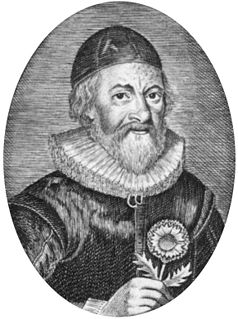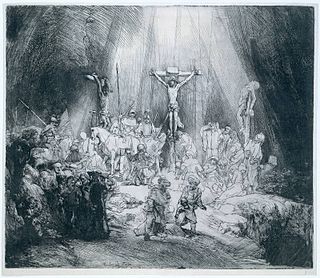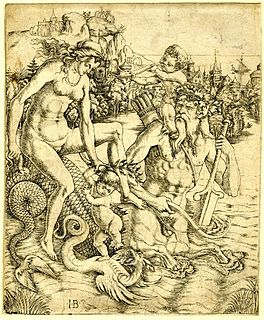
Albrecht Dürer, sometimes spelled in English as Durer or Duerer, was a German painter, printmaker, and theorist of the German Renaissance. Born in Nuremberg, Dürer established his reputation and influence across Europe in his twenties due to his high-quality woodcut prints. He was in contact with the major Italian artists of his time, including Raphael, Giovanni Bellini and Leonardo da Vinci, and from 1512 was patronized by Emperor Maximilian I.

Albrecht Altdorfer was a German painter, engraver and architect of the Renaissance working in Regensburg, Bavaria. Along with Lucas Cranach the Elder and Wolf Huber he is regarded to be the main representative of the Danube School setting biblical and historical subjects against landscape backgrounds of expressive colours. He is remarkable as one of the first artists to take an interest in landscape as an independent subject. As an artist also making small intricate engravings he is seen to belong to the Nuremberg Little Masters.

John Speed was an English cartographer and historian. He is, alongside Christopher Saxton, one of the best known English mapmakers of the early modern period.

John Evelyn was an English writer, gardener and diarist.
The year 1629 in science and technology involved some significant events.
John Gerard was an English herbalist with a large garden in London. His 1,484-page illustrated Herball, or Generall Historie of Plantes, first published in 1597, became a popular gardening and herbal book in English in the 17th century. Except for some added plants from his own garden and from North America, Gerard's Herbal is largely a plagiarized English translation of Rembert Dodoens's 1554 herbal, itself highly popular in Dutch, Latin, French and other English translations. Gerard's Herball drawings of plants and the printer's woodcuts are mainly derived from Continental European sources, but there is an original title page with a copperplate engraving by William Rogers. Two decades after Gerard's death, the book was corrected and expanded to about 1700 pages. The botanical genus Gerardia was named after Gerard.

A herbal is a book containing the names and descriptions of plants, usually with information on their medicinal, tonic, culinary, toxic, hallucinatory, aromatic, or magical powers, and the legends associated with them. A herbal may also classify the plants it describes, may give recipes for herbal extracts, tinctures, or potions, and sometimes include mineral and animal medicaments in addition to those obtained from plants. Herbals were often illustrated to assist plant identification.

Jodocus Hondius was a Flemish and Netherlandish engraver and cartographer. He is sometimes called Jodocus Hondius the Elder to distinguish him from his son Jodocus Hondius II. Hondius is best known for his early maps of the New World and Europe, for re-establishing the reputation of the work of Gerard Mercator, and for his portraits of Francis Drake. One of the notable figures in the Golden Age of Dutch/Netherlandish cartography, he helped establish Amsterdam as the center of cartography in Europe in the 17th century.

Marcantonio Raimondi, often called simply Marcantonio, was an Italian engraver, known for being the first important printmaker whose body of work consists largely of prints copying paintings. He is therefore a key figure in the rise of the reproductive print. He also systematized a technique of engraving that became dominant in Italy and elsewhere. His collaboration with Raphael greatly helped his career, and he continued to exploit Raphael's works after the painter's death in 1520, playing a large part in spreading High Renaissance styles across Europe. Much of the biographical information we have comes from his life, the only one of a printmaker, in Vasari's Lives of the Artists.

Mathias de l'Obel, Mathias de Lobel or Matthaeus Lobelius was a Flemish physician and plant enthusiast who was born in Lille, Flanders, in what is now Hauts-de-France, France, and died at Highgate, London, England. Graduating in medicine from the University of Montpellier in 1565 he practiced medicine in the low countries and England, including positions as personal physicians to two monarchs. A member of the sixteenth century Flemish School of Botany, he wrote a series of major treatises on plants in both Latin and Dutch. He was the first botanist to appreciate the distinction between monocotyledons and dicotyledons. The Lobelia plant is named after him.

John Parkinson was the last of the great English herbalists and one of the first of the great English botanists. He was apothecary to James I and a founding member of the Worshipful Society of Apothecaries in December 1617, and was later Royal Botanist to Charles I. He is known for two monumental works, Paradisi in Sole Paradisus Terrestris, which generally describes the proper cultivation of plants; and Theatrum Botanicum, the most complete and beautifully presented English treatise on plants of its time. One of the most eminent gardeners of his day, he kept a botanical garden at Long Acre in Covent Garden, today close to Trafalgar Square, and maintained close relations with other important English and Continental botanists, herbalists and plantsmen.
Map Man is a BBC documentary series first broadcast on BBC Two in 2004 and repeated in 2013. Each episode recounts a particular tale in the history of British cartography, with a particular emphasis on the individuals whose dedication and ingenuity led to the production of some of history's most ground-breaking maps.

Buxus sempervirens, the common box, European box, or boxwood, is a species of flowering plant in the genus Buxus, native to western and southern Europe, northwest Africa, and southwest Asia, from southern England south to northern Morocco, and east through the northern Mediterranean region to Turkey. Buxus colchica of western Caucasus and B. hyrcana of northern Iran and eastern Caucasus are commonly treated as synonyms of B. sempervirens.

An old master print is a work of art produced by a printing process within the Western tradition. The term remains current in the art trade, and there is no easy alternative in English to distinguish the works of "fine art" produced in printmaking from the vast range of decorative, utilitarian and popular prints that grew rapidly alongside the artistic print from the 15th century onwards. Fifteenth-century prints are sufficiently rare that they are classed as old master prints even if they are of crude or merely workmanlike artistic quality. A date of about 1830 is usually taken as marking the end of the period whose prints are covered by this term.

The Master of the Playing Cards was the first major master in the history of printmaking. He was a German engraver, and probably also a painter, active in southwestern Germany - probably in Alsace, from the 1430s to the 1450s, who has been called "the first personality in the history of engraving."
John Jackson (1801–1848) was a British wood-engraver.

The cayenne pepper is a type of Capsicum annuum. It is usually a moderately hot chili pepper used to flavor dishes. Cayenne peppers are a group of tapering, 10 to 25 cm long, generally skinny, mostly red-colored peppers, often with a curved tip and somewhat rippled skin, which hang from the bush as opposed to growing upright. Most varieties are generally rated at 30,000 to 50,000 Scoville units.

John Lawrence was an English writer on political and agricultural subjects, chiefly known for being an early proponent of ethical treatment of animals.

Giovanni Battista Palumba, also known as the Master I.B. with a Bird, was an Italian printmaker active in the early 16th century, making both engravings and woodcuts; he is generally attributed with respectively 14 and 11 of these. He appears to have come from northern Italy, but later worked in Rome. He specialized in subjects from classical mythology, as well as the inevitable religious subjects. Despite his relatively small output, he was a sophisticated artist, whose style shows a number of influences and changes, reflecting awareness of the currents in artistic style at the start of the High Renaissance. The signed prints are usually dated to around 1500–1511.

John Baptist Jackson (1701–1780) was a British artist, a woodcut printmaker of the eighteenth century. He lived and worked in Paris and Venice. Jackson was prolific, ambitious and innovative within the medium, and produced both chiaroscuro and polychrome prints, as well as wallpaper.

















